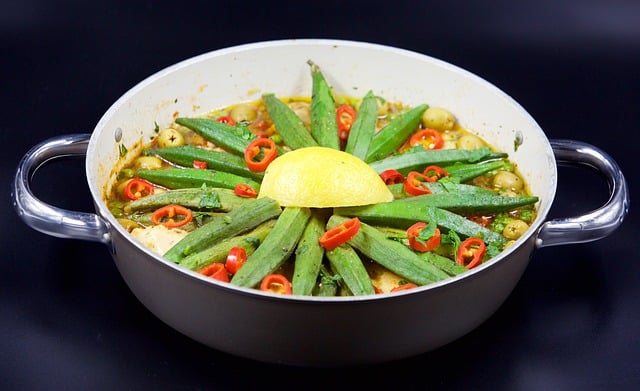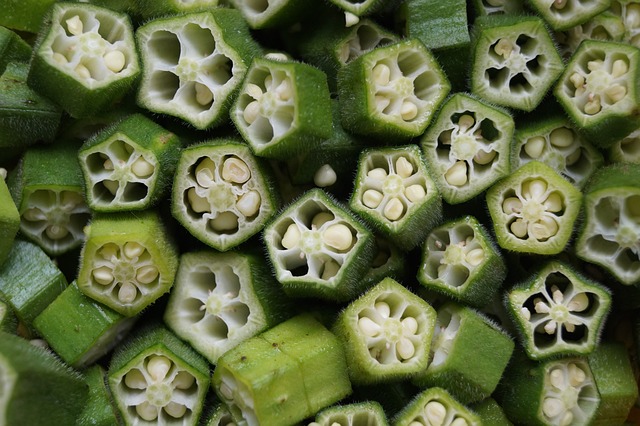Introduction – The Mystery of Okra’s Sliminess
Getting to sustainable food means finding value in all the foods that are grown around the year and in every climate. Okra is not as commonly consumed as other vegetables so we’re going to address some issues about okra and cooking it. Okra is a member of the mallow family (Malvaceae) of flowering plants with large, typically heart-shaped leaves and edible green fruit. Okra is very peculiar in its appearance, it bears more resemblance to a small cucumber than to the average vegetable, but it has received considerable praise for its taste despite being one of the most difficult vegetables to prepare.

It originated in Africa and is widespread throughout the world’s tropical regions, including India, where it is known as bhindi or bendakaya, and Australia, where it is commonly called lady’s fingers. Okra can be cooked in various ways: stuffed, stewed, stir-fried, and deep-fried. It finds extensive use as a thickener in soups and stews; when boiled whole, its green pods are left as a viscous liquid that is poured into the dish, thickening its consistency.
Is Okra Slimy?
There’s no denying that Okra can get slimy when cooked, and many people don’t like it. However, there are ways to minimize the slippery texture and some great ways to use Okra in your cooking! For example, you can slice Okra thinly and roast it for a delicious side dish – this helps make it less slimy because heat does reduce its ability to glom onto other ingredients.
You can also saute chopped Okra with garlic, onions, and chile peppers to add flavor without much of the typical mildewed-mushroom quality to the finished product. If you’re looking for a way to avoid the slime factor altogether, consider making okra pickles or fermenting it as kimchi; both methods will prevent any kind of sponginess, thanks to the vinegar and salt used in pickling or bribing.
So, is Okra slimy? In most cases, yes – but with some knowledge, you can still enjoy this healthy and versatile vegetable!
Why Is Okra So Slimy?
When cooked, Okra releases a viscous substance known as mucilage. Polysaccharides form this slime, long chains of sugar molecules also found in other plants, such as aloe vera and psyllium husk. Mucilage serves multiple purposes in the plant’s life cycle, including helping seeds disperse and protecting against drought and pests.
In the kitchen, this slimy substance can serve as a thickener in soups and stews or even be used as an egg substitute in vegan baking. While its texture may not be to everyone’s taste, Okra’s mucilage adds culinary potential and nutritional value to dishes. So next time you see Okra’s slippery texture on your plate, remember that it serves a purpose beyond just being slimy.
What’s The Right Way To Cook With Okra?
Okra’s texture can be a bit polarizing – some love its slimy consistency, while others are less enthusiastic. But whether you’re a fan or not, the key to cooking with Okra is all in the preparation. The first step is to thoroughly wash and dry the Okra before slicing off the stem end and cutting it into desired shapes.
Next, consider what cooking method you plan on using. If you’re adding it to dishes like soups or stews, simply toss it in with the rest of your ingredients during the cooking process. But if you want to fry or roast your Okra, it’s best to sprinkle it with cornmeal or bread crumbs for added crispness before cooking.
And finally, make sure not to overcook your Okra – it should still have a bit of bite to it when finished cooking. By following these simple steps, you’ll be able to enjoy all the unique flavors that Okra has to offer.
Health Benefits of Okra
Despite its slightly off-putting appearance, Okra has become a popular vegetable in many parts of the world. Its health benefits include:
- Rich in vitamins and minerals. Okra contains nutrients, including vitamin C, B vitamins, folate, and potassium.
- Contains antioxidants. The polysaccharides in okra help protect against oxidative damage caused by free radicals. This makes it a great choice for preventing chronic diseases like heart disease and cancer.
- May lower blood sugar levels. Studies have shown that eating foods with high amounts of soluble fiber can reduce the glycemic index of a meal, helping to keep blood sugar stable after eating. Because Okra is full of soluble fiber and has been shown to help regulate blood sugar, it can be a beneficial food for those with diabetes or prediabetes.

How To Avoid The Sliminess Of Okra While Cooking?
There are a few different methods for cooking Okra, so it’s not slimy. One option is to saute the Okra in oil or butter over low heat. This helps to soften the vegetable and prevent excess liquid from being released.
A popular way to reduce the amount of slime emitted by Okra is to soak it in vinegar for 30 minutes before cooking. This will help to break down the mucilage, making it more palatable and less slimy. Okra’s mucilage is also released when it’s pickled or fermented, so if you enjoy these flavorful preparations, they may be a good option for reducing the sliminess.
Another option is to bread the Okra before frying or roasting. Coating the vegetable with cornmeal or bread crumbs can give it a crispy texture and prevent excess liquid from being released during cooking. This can help reduce its slimy texture by adding crispness and removing excess moisture.
And regardless of how you choose to cook your Okra, remember to avoid overcooking – this will make it even more gooey and slippery than usual. With the right technique and patience, you’ll be able to enjoy all the delicious flavor Okra has to offer without having to deal with its slimy texture.
You can also roast the Okra at a high temperature by baking or grilling. This will help create a crispy outer shell that prevents any sliminess from seeping out. Finally, you can pickle or ferment your Okra to remove its mucilage, leaving you with an extra-crisp texture that tastes delicious no matter how you prepare it!
Conclusions
In conclusion, there are a few different ways to avoid the sliminess of Okra when cooking. Some options include sauteing, pickling or fermenting, crispness bread, and roasting at high temperatures. With a little experimentation and patience, you can enjoy all the delicious flavor this nutrient-rich vegetable has to offer!
